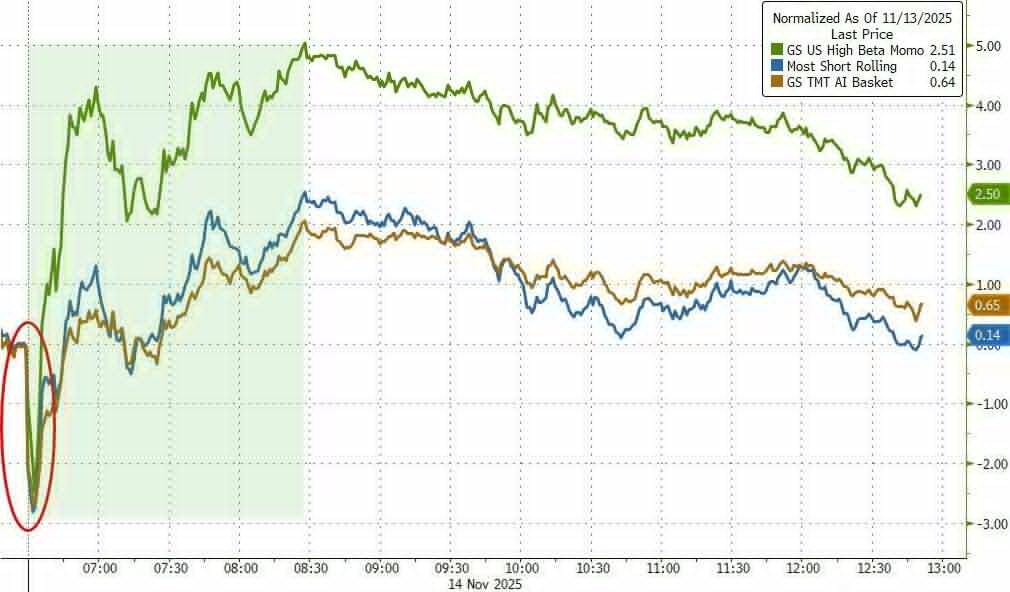Tech stocks are attracting bottom-fishing capital, gold has rebounded after a sharp drop, but bitcoin is sinking alone, “unable to recover.” What exactly is happening behind this? Why has the once-glorious crypto market become “miserable beyond words”?
On Friday (November 14), the US stock market saw a dramatic reversal. After a panic sell-off at the open, funds rushed into tech stocks, and both the Nasdaq and S&P 500 rebounded strongly after hitting key technical support levels. Gold, after plunging more than $150 intraday, also rebounded to around $4,080, but bitcoin was a clear exception: it fell 5% that day, breaking below the $94,000 mark and hitting a six-month low.
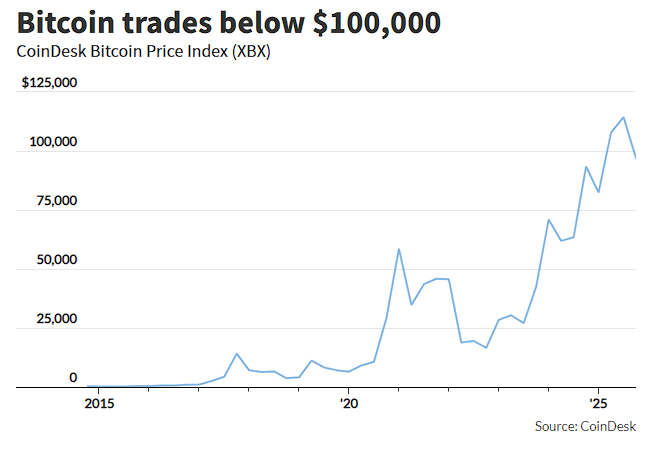
This marks bitcoin’s third consecutive week of decline and its fifth drop in the past six weeks. Even more shocking, since the flash crash on October 10, the shockwaves in the crypto market have shown no sign of abating—the total market value of all cryptocurrencies has lost over 1 trillion USD.
This contrast reveals bitcoin’s abnormal situation: while maintaining a 0.8 correlation with the Nasdaq 100 Index, bitcoin shows an asymmetric pattern of “falling harder, rising weaker.” More notably, according to an article from Wallstreetcn, the crypto Fear & Greed Index has dropped to 15, the lowest since February this year. The last time the index fell below 20, bitcoin plunged 25% within a month.
Meanwhile, multiple factors are jointly suppressing bitcoin. Long-term holders have sold about 815,000 bitcoins in the past 30 days, the highest since the start of 2024; market liquidity has dried up, leading to five consecutive weeks of net outflows from bitcoin ETFs. Even the Trump family’s crypto-related wealth has not been spared, with their holdings in World Liberty Financial tokens and American Bitcoin stocks both falling about 30% from their highs.
Tech Stocks Stage a Comeback, Bitcoin Plunges Against the Trend
Friday’s market performance was a tale of “fire and ice.” The Nasdaq 100 and S&P 500 rebounded quickly after hitting their 50-day moving average support, and small-cap stocks also found support at their 100-day moving average. According to Goldman Sachs trader Scott Rubner, market sentiment experienced a dramatic shift from “absolute panic” (4:00 a.m. to 9:30 a.m.) to “strong comeback” (10:00 a.m. to 11:00 a.m.) in the morning.
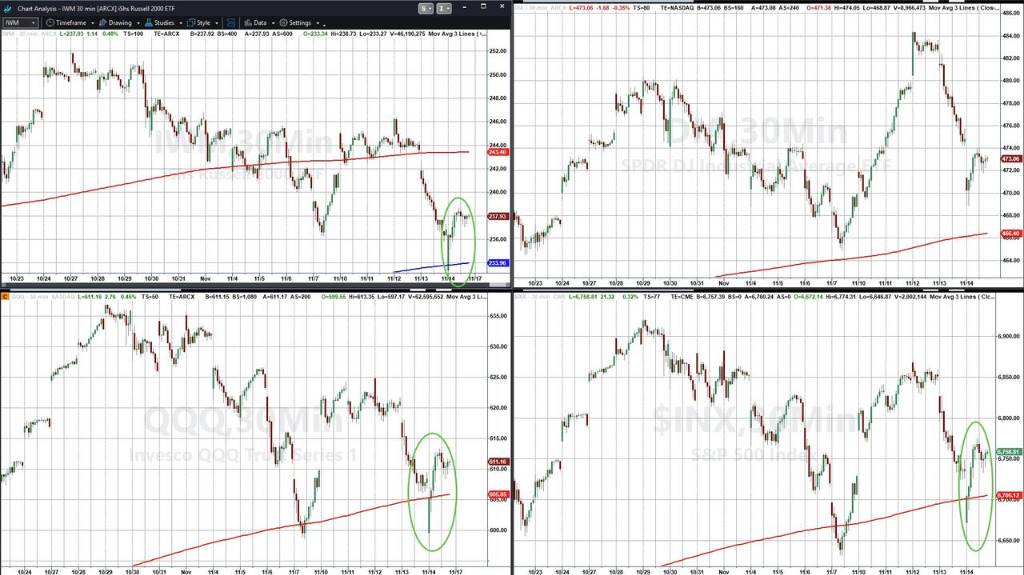
This V-shaped reversal was no accident. Goldman Sachs data shows that after a single-day drop of at least 1.5% in the S&P 500 in 2025, the average rebound the next day is 1.1%.
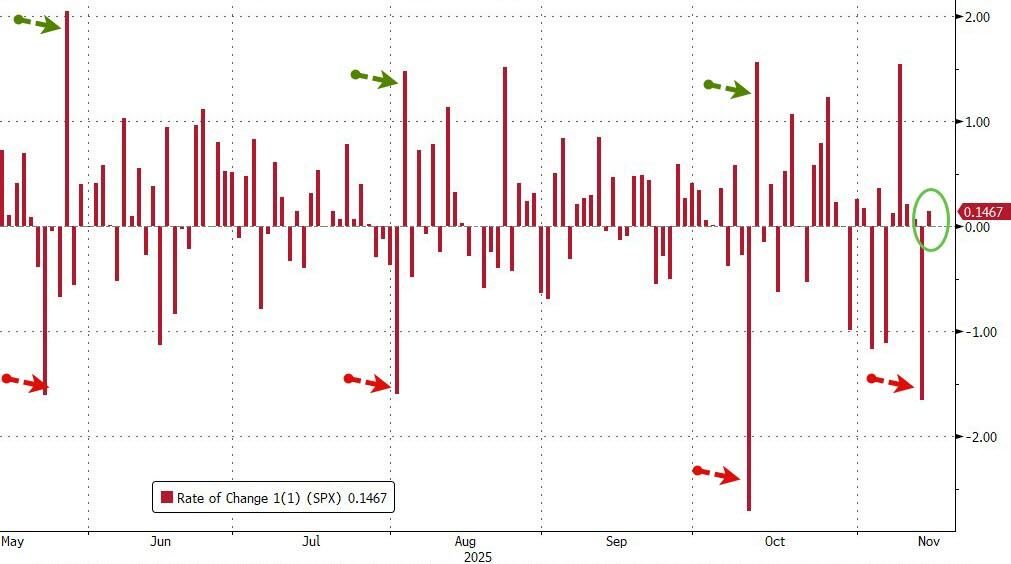
ETF trading activity was the main force behind early bottom-fishing, accounting for 37% of the day’s trading volume, far above the annual average of 27%. The tech giant Mag7 Index rebounded strongly after touching its 50-day moving average, ending the week flat, with hedge fund covering demand at the 96th percentile.
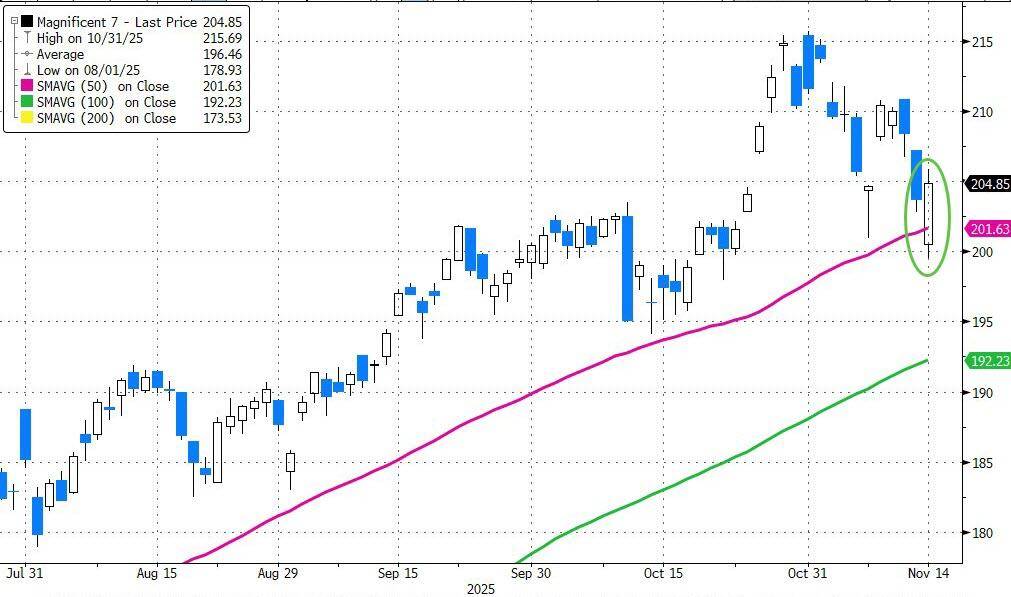
However, bitcoin did not participate in this rebound feast at all. On Friday, bitcoin fell 5%, hitting a low of $94,519, the lowest since May 6, with a weekly decline of 9.14%, marking its worst weekly performance since the week of February 28. Since reaching its all-time high of $126,272 on October 5, bitcoin has fallen about 25% in total.

This divergence is particularly glaring against the backdrop of improving market liquidity. Goldman Sachs traders pointed out:
Hedge funds are buying across the board, with demand at the 96th percentile; high-beta momentum stocks, most shorted stocks, and AI leaders all rebounded from a 3% drop at the open to close up 3%. But the bitcoin market remains under pressure, indicating it is experiencing a different predicament from traditional risk assets.
“Falls Harder, Rises Weaker”: The Distorted Correlation
Bitcoin’s correlation with the Nasdaq 100 Index remains as high as 0.8, but this relationship is distorted—bitcoin only moves in sync with the stock market during declines, but is sluggish during rallies.
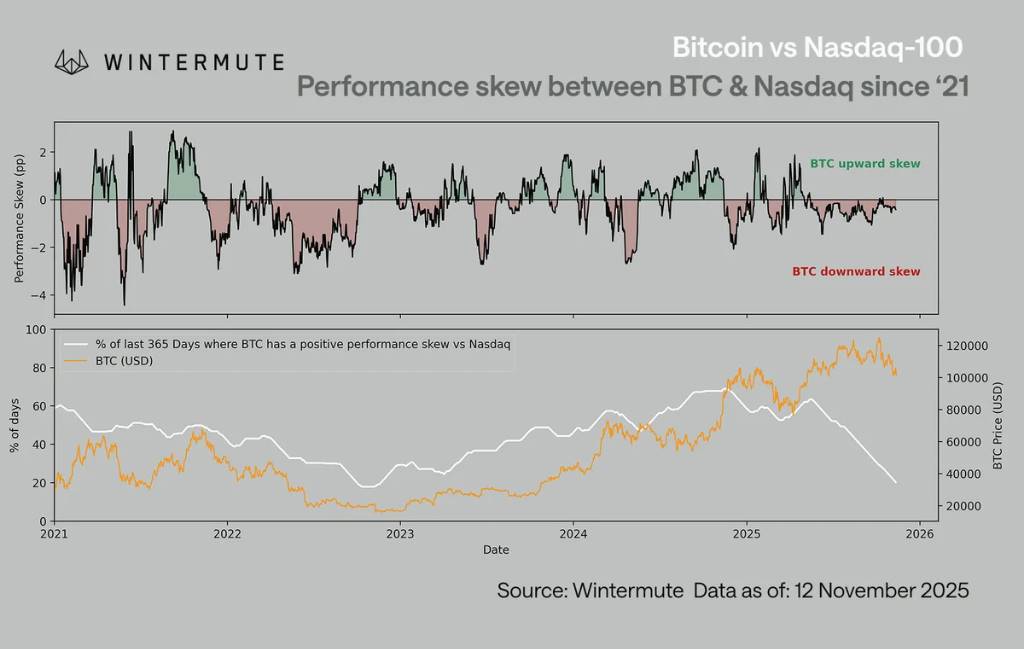
Data shows that since the start of this year, the performance skew between bitcoin and the Nasdaq has been significantly negative:
When the Nasdaq rises, bitcoin’s gains are noticeably smaller; when the Nasdaq falls, bitcoin drops even more. This is not a collapse of correlation, but an asymmetry—bitcoin absorbs downside risk but cannot share in the upside gains.
More notably, this negative skew on a 365-day rolling basis has reached its highest level since the bear market at the end of 2022—exactly one year after bitcoin peaked in the previous cycle.
Historical experience shows that such a scale of negative asymmetry usually appears when market sentiment is extremely weak and prices are near the bottom, not at highs. What is the logic behind this anomaly?
A shift in market attention is a key factor. In 2025, the narrative capital that originally flowed into the crypto sector—new token issuances, infrastructure upgrades, retail participation—has shifted to the stock market.
Large tech stocks have become magnets for institutions and retail investors seeking high-beta growth. Compared to the frenzy of 2020-2021, the marginal increase in risk appetite now flows more into the Nasdaq than into digital assets.
This means bitcoin retains its high-beta attribute as a macro risk asset during downturns, but has lost its narrative premium during rallies. It only reacts as a “high-beta tail” of macro risk, not as an independent investment theme.
Changes in liquidity structure have exacerbated this asymmetry. Stablecoin issuance has peaked, ETF inflows have slowed, and exchange market depth has not recovered to early 2024 levels.
This fragility amplifies bitcoin’s negative reaction during stock market pullbacks, causing its downside participation to consistently exceed its upside participation.
Crypto Fear Index Plunges to Yearly Low
Market sentiment indicators are confirming this extremely pessimistic atmosphere. According to Wallstreetcn, on November 13, the crypto Fear & Greed Index plunged to 15, the lowest since February this year.
This “extreme fear” reading is alarming—the last time the index fell below 20 was on February 27, after which bitcoin fell 25% to $75,000 within a month.
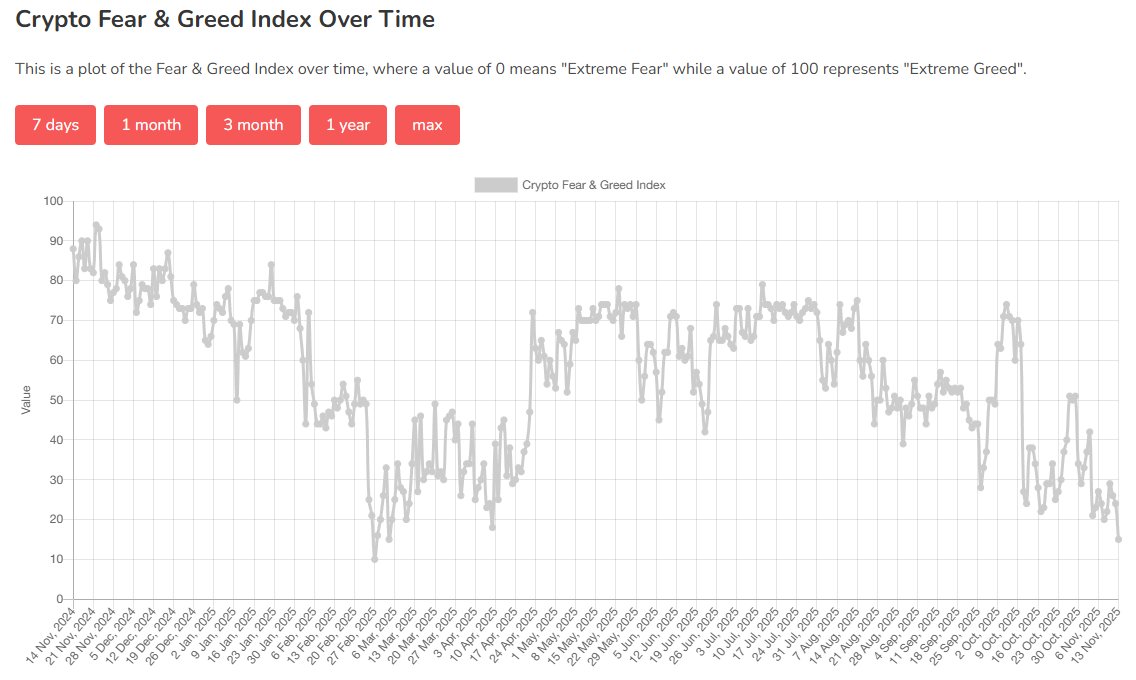
According to a report from sentiment analysis platform Santiment, negative discussions about bitcoin, ethereum, and XRP have surged, with the positive/negative sentiment ratio dropping sharply and sentiment levels far below normal.
This indicates that negative discussions are dominating the market narrative, and investor confidence remains persistently low.
Since the large-scale liquidation event on October 11, key sentiment indicators show that market sentiment has never recovered and has instead deteriorated further.
Although Santiment interprets this extreme negative sentiment as a potentially bullish signal indicating a local bottom, the current price action clearly shows no sign of a definitive reversal yet.
Whale Sell-Offs Intensify, Long-Term Holders Concentrate on Selling
As bitcoin remains “unable to recover,” multiple factors are jointly suppressing it.
Reports indicate that behind bitcoin’s fall below the key $100,000 milestone, “whales” (large holders with over 1,000 bitcoins) and long-term holders have been significant drivers of the sell-off.
Blockchain data shows that in the past 30 days, long-term bitcoin holders have sold about 815,000 bitcoins, the highest level of selling since the start of 2024. More crucially, whale wallets holding bitcoin for over seven years have been selling at a rate of more than 1,000 bitcoins per hour.
This sell-off is characterized by “sustained, staggered distribution” rather than sudden coordinated dumping. Analysis shows that many early holders view $100,000 as a psychological threshold—a profit-taking level they have discussed for years. Since bitcoin first broke $100,000 in December 2024, long-term holders’ selling has accelerated.
Bitcoin industry veteran and Swan Bitcoin CEO Cory Klippsten said:
“Many early holders I know have been talking about the $100,000 number since I entered the space in 2017. For some reason, that’s the level people have always said they would sell some.”
However, what’s truly concerning is not the selling itself, but the market’s diminishing ability to absorb these sales. At the end of last year and the beginning of this year, when long-term holders sold bitcoin, other buyers would step in to support the price, but this dynamic seems to have changed.
ETF fund flows confirm the weak demand. As of Thursday, bitcoin ETFs had a net outflow of $311.3 million this week, marking the fifth consecutive week of outflows—the longest streak since March 14. The past five weeks have seen a cumulative outflow of $2.6 billion, second only to the $3.3 billion outflow in the five weeks ending March 28.
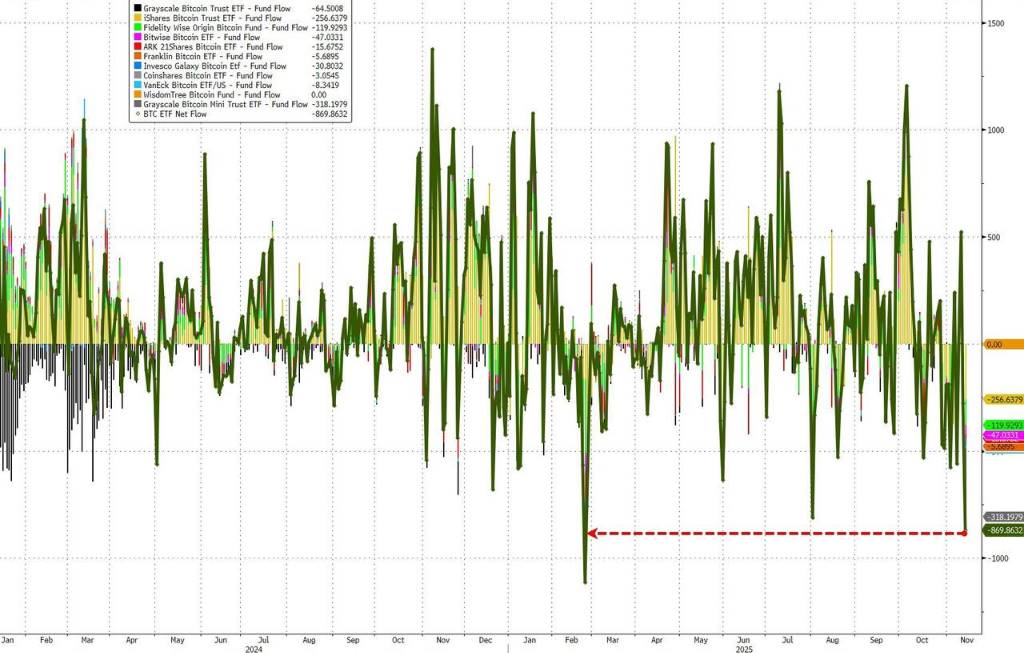
Trump Family Wealth Also Hit Hard
As the crypto market experiences turbulence, the Trump family’s wealth from crypto has also shrunk.
In the month since bitcoin hit its $126,272 high on October 5, the stocks and tokens related to crypto held by Trump and his family have all fallen sharply.
The Trump family’s crypto portfolio includes Trump Media & Technology Group, blockchain company World Liberty Financial, and bitcoin mining firm American Bitcoin. World Liberty Financial tokens, as well as shares of American Bitcoin and DJT, have all fallen about 30% since bitcoin’s October high.
According to President Trump’s mid-June government financial disclosure, he indirectly holds nearly 115 million DJT shares through a revocable trust under his son Don Jr., worth about $1.3 billion at Friday’s price, down sharply from nearly $2 billion in early October.
The World Liberty website shows that Trump and his family hold about 22.5 billion World Liberty Financial tokens, worth about $3.4 billion at Friday’s price, down from a peak of $4.5 billion. Eric Trump holds a 7.5% stake in American Bitcoin, currently worth about $340 million, down from a peak of $480 million.
Despite the Trump administration’s many efforts to promote the crypto industry—including establishing a bitcoin “strategic reserve” and the US Securities and Exchange Commission dropping lawsuits against companies like Coinbase and Binance—these policy tailwinds have failed to prevent the sharp correction in the crypto market.

